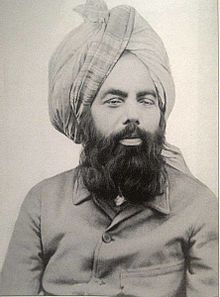Ahmadiyya
![]()
The title of this article is ambiguous. For the Sufi order also called Ahmadiyya, see Badawiyya.
The Ahmadiyya (Urdu احمدیہ 'Ahmad-tum') is an Islamic community founded by Mirza Ghulam Ahmad in British India in the 1880s. From 1889, followers took the oath of allegiance to him. They registered themselves in the official census lists of the British Indian administration in 1901 under the name Ahmadiyya Musalmans.
The religious community, which sees itself as a reform movement of Islam, adheres to the Islamic sources of law - the Koran, Sunna and Hadith - with the writings and revelations of Mirza Ghulam Ahmad additionally having considerable significance. The community considers itself to belong to Islam. On the part of most other Muslims, however, the Ahmadiyya teachings are regarded as heresy and rejected. In Islamic countries, the religious communities and their activities are opposed accordingly, leading to restrictions and persecution in these countries.
The community founded by Mirza Ghulam Ahmad split into two groups, the Ahmadiyya Muslim Jamaat (AMJ) and the Ahmadiyya Andschuman Ishat-i-Islam Lahore (AAIIL), over the issue of succession after the death of his successor Nuur ud-Din, with the AMJ largely displacing the AAIIL. The AMJ's current headquarters are in London, UK, while the AAIIL has its international headquarters in Lahore. Ghulam Ahmad's successors are referred to by the AMJ as Khalifat ul-Massih (Successors of the Messiah).

Mirza Ghulam Ahmad, founder of the Ahmadiyya
Origin and naming
Mirza Ghulam Ahmad came from an aristocratic family of Persian descent. In 1882, he published the first two volumes of his magnum opus Barāhīn-i Ahmadiyya ("Proofs of Ahmad-tum"), which was initially regarded among Muslims as a work full of power and originality. Mirza Ghulam Ahmad emerged as an Islamic innovator (mujaddid) and in a public proclamation in late 1888 invited all people "who are seekers of truth (to) take the oath of allegiance to him so as to learn the true faith, the true purity of religion, and the way of loving God." The Pledge of Allegiance ceremony then took place in Ludhiana on March 23, 1889. This event is considered to be the actual founding date of the Ahmadiyya Movement.
In December 1891, Ghulam Ahmad announced that his movement would hold annual gatherings in Qadian. Ahmad referred to himself from that year on as the Mahdi announced by Prophet Muhammad and saw himself as the prophesied Second Coming of Jesus Christ, Krishna and Buddha in one person. His God-given mission was the unification of all religions under the banner of Islam.
Ghulam Ahmad's followers came mainly from the literate middle class, who knew how to understand his complex language. The denomination was not officially named until a census in 1901, when Ahmad recommended that his followers register as "Ahmadiyya Musalmans". Popularly, they were called "Qadiani" or "Mirzai" until then.
Mirza Ghulam Ahmad derived the name "Ahmadiyya" from the second name of the Prophet Muhammad, who is referred to as Ahmad in Quranic verse 61:6 by Isa ibn Maryam.
The name Muhammad in Arabic means "praised one" or "praised one". Mirza Ghulam Ahmad understood this to mean the work of Muhammad in the Medinan period of prophecy, which he characterized as "triumphant". Ahmad means "the praising one" or "the praising one". This, according to Mirza Ghulam Ahmad, manifested itself in the Meccan period of prophecy, which Mirza Ghulam Ahmad associates with praising God.
Mirza Ghulam Ahmad justified the naming by saying that Muhammad stood for glory and majesty ("Jalali"), while Ahmad emphasized beauty ("Jamali"). In this way, Ahmad harkens back to the early period in Muhammad's preaching.
The derivation of the term "Ahmadiyya" is disputed: "The Aḥmadīs claim to derive their name not from that of the sect's founder, but from the promise about him in the Qur'an." In distinction to this claim, the term "Qādiyānīya" or "Mirzaiyya" is also used; accordingly, followers are called "Qādiyānī" or "Mirzai."

Mirza Ghulam Ahmad (center) and his early followers. To his right sits his later successor Nuur ud-Din
Split
After Ahmad's demise, the physician and theologian Nuur ud-Din was elected head of the Ahmadiyya Movement. With his election on 27 May 1908, the Khalifat was established after the Promised Messiah.
Criticism soon arose of the caliphate system, which was and is perceived by opponents as autocratic. After Nuur ud-Din's death in 1914, dissent over it broke out openly. Especially the executive body was controlled by "opponents of the caliphate".
- Some 1,500-2,000 supporters of the caliphate elected Mirza Bashir ud-Din Mahmud Ahmad as the second caliph and thus the new spiritual leader. The committee (anjuman) is subject to the caliph's instructions. The group remaining in Qadian later called itself the Ahmadiyya Muslim Jamaat (AMJ). The caliphs of the AMJ are elected for life by an electoral committee. Since 2003, Mirza Masrur Ahmad has been the spiritual head of the AMJ as Khalifat ul-Massih V.
- Some 50 Ahmadis - led by Muhammad Ali and Khwaja Kamal ud-Din - refused allegiance to Mirza Bashir ud-Din Mahmud Ahmad and established a presidency led by an emir in Lahore. The baiat and a spiritual leadership were to be dispensed with. The group that moved out to Lahore later called itself Ahmadiyya Andschuman Ishat-i-Islam Lahore (AAIIL).
Mirza Bashir ud-Din Mahmud Ahmad was able to win over the majority of supporters, but the Qadian Group (AMJ) was severely weakened under the 25-year-old, inexperienced leader and without an intellectual, executive and administrative elite. The Lahore group (AAIIL) was at the same time financially stronger and was soon able to open mission stations in Woking and Berlin. Later, mission stations were added in Suriname and the Netherlands.
However, Mirza Bashir ud-Din Mahmud Ahmad was able to consolidate the Qadian Group (AMJ) during his tenure and develop it into a powerful organization. As a result, the AMJ was able to gain members vigorously, while the AAIIL stagnated. The AAIIL is still active today with publications and mission work, but no longer plays a role numerically and has slipped into insignificance. Since the split, both groups are also known as Qadiani (for AMJ) and Lahori (for AAIIL), especially in India and Pakistan. These terms are used pejoratively by opponents of Ahmadiyya.
See also: Ahmadiyya Muslim Jamaat and Lahore Ahmadiyya Movement

Flag of the Ahmadiyya Muslim Jamaat
Questions and Answers
Q: What is Ahmadiyya?
A: Ahmadiyya is an Islamic movement founded in the 19th Century by Mirza Ghulam Ahmad who claimed to be the Mahdi and Promised Messiah. The goal of the movement was to restore Islam's original message.
Q: How did the Ahmadiyya Movement split?
A: The movement split into two different groups in 1914, over a question of who should become the next Caliph. Both groups still exist today.
Q: Who was Mirza Ghulam Ahmad?
A: Mirza Ghulam Ahmad was the founder of the Ahmadiyya Muslim Community and claimed to have fulfilled prophecies for the Mahdi. He was also called Mujaddid (divine reformer) of the 14th Islamic century and promised Messiah.
Q: What are two main factions within Ahmediyya?
A: The two main factions within Ahmediyya are known as the Ahmadi Community and Lahore Ahmadi Movement for Propagation of Islam (Ahmadiyya Anjuman Ishaat-i-Islam, AAIIL).
Q: Where are International Headquarters located for each faction?
A: The International Headquarters of the Ahmadi Community is currently in London, England while that of Lahore Ahmadi Movement is located in Lahore, Pakistan where it started.
Q: What controversial points do members of Ahmediyya face?
A: Controversial points include their view on death and return of Jesus, concept of Jihad, interpretation verse Qur'an 33:40 which talks about Muhammad as Seal Prophets, and being considered heretics by mainstream Muslims despite claiming to practice same Islam taught by Muhammad and his followers.
Q: How does Ahmediyyas promote their beliefs globally?
A:Ahmedis promote their beliefs globally through translations of Qur'an in all major languages, 24-hour satellite television channels such as MTA 1, MTA 2 & 3 , providing teachers , doctors & humanitarian relief workers in many developing countries & promoting homeopathy system medicine through regular TV classes & free dispensaries around world .
Search within the encyclopedia